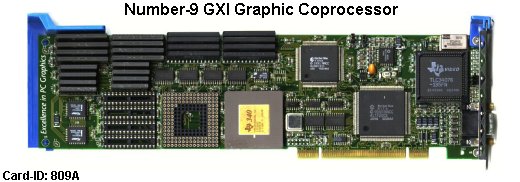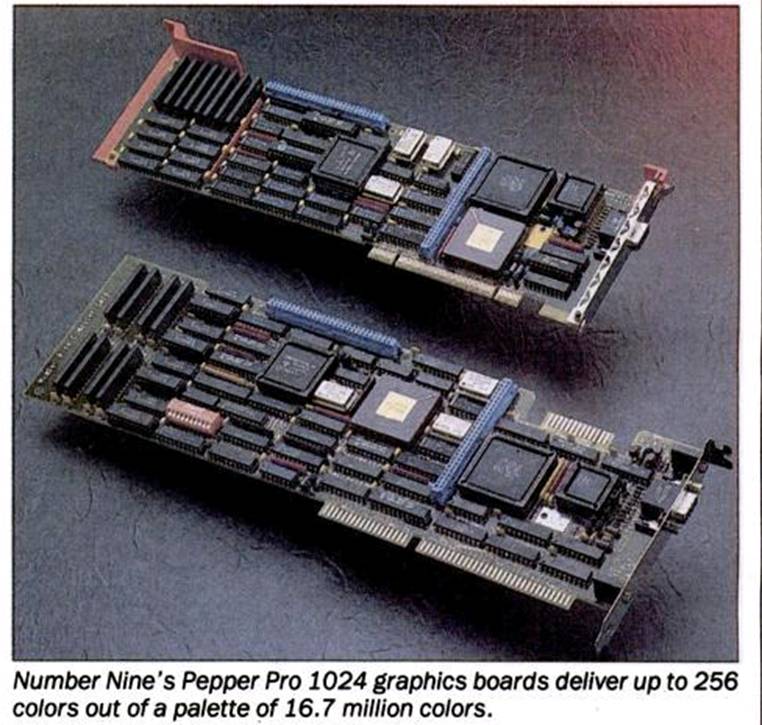Number Nine Pepper SGT
(#9GX?)
@8099.adf ADF for #9GX
@809A.adf ADF for #9GXi
If you have other files, send me a copy!
GX.zip Files for GX
GXi.zip Files for GXi
Pepper.zip Files for Pepper
Pro1280.zip Files for Pro1280
TIGA.zip TIGA files
Apologies, but there is shared confusion over levels and models.
Number Nine Pepper SGT (#9GX?)
@809A.adf ADF for #9GXi
If you have other files, send me a copy!
GX.zip Files for GX
GXi.zip Files for GXi
Pepper.zip Files for Pepper
Pro1280.zip Files for Pro1280
TIGA.zip TIGA files
Apologies, but there is shared confusion over levels and models.
Number Nine Pepper SGT (#9GX?)

| CN1
HDD15 D11 LED for ??? E1-8 KM44C256BZ-7 F1,2 Fuseable link? JM1 SOG (Sync On Green) JM3 MDA (Monochrome Diisplay Adapter) JM6 IRQ3 JM7 IRQ12 JM9 Pedestal JM11 Solder pads, Unk JM12 Solder Pads, Unk U12 Number Nine NN9092 |
U13 Bt478KPJ80 256 color RAMDAC U19 TI TMS 34010FNH-60 U26 Number Nine NN9091 U27-41 D42274V-10 U43 Bt459KPF135 Hi color RAMDAC U46 BIOS ver 3.17 Y1 80.00000 MHz osc Y2 44.90000 MHz osc Y3 64.000000 MHz osc Y5 60.00000 MHz osc Y6 107.000000 MHz osc 0 |
Thanks to Tim Knight for sending me the board. Further thanks to the Wizard of Oz for further #9 information.
Two RAMDAC on board, linked to a TIGA. Might this be the Bt459 for hi-color, and the Bt478 for MDA?
F1 and F2 are odd. They are two what looks to be solder pads that touch. Dunno, the idea of an exposed fusible link that might leak a little dot of solder onto the systemboard is unusual.
Number Nine Computer Corporation, Cambridge, Massachusetts (company later became Number Nine Visual Technologies, Lexington, Massachusetts and then became part part of SonicBlue, Inc. - formerly S3, Inc.)
NNIOS, Number Nine's Intelligent Operating System Number Nine created our own graphics operating system called NNios™(Number Nine Intelligent Operating System). NNios was resolution, color and even processor independent. NNios was a unique innovation in graphics display programming, and offered developers assurance that a single driver would support multiple boards.
MDA uses the memory range B000-B7FF while the graphics mode display uses A000-AFFF for it's color plane buffer
The Number Nine Graphics Card and Windows 3.1 (This may not apply to the Pepper SGT)
If you use a Number Nine Graphics Card Model GX with Win 3.1, you should have the TIGA display driver installed.
Number Nine techl support recommends using the Windows TIGA display driver. You may also want to add an EMMExclude statement in the [386Enh] section of the SYSTEM.INI file. This line should read as follows: EMMExclude=C000-CFFF
NOTE: You may need to upgrade your Number Nine Graphics card if problems occur when you run Windows version 3.1.
#9GXi

GXi cards use a Texas Instruments TMS-34020 graphics co-processor
Wizard of Oz spoke thusly:
From looking at this pic, I think it is a GXi in MCA, not a GX (it's even labeled GXI (should be GXi, methinks)). (I think your line drawing is either a Pepper or a GX, but I'm 99% it is NOT a GXi.)
I have a GXi in ISA, and it is similar to this pic. Both are different from your line drawing. The empty processor socket is for a TMS-340x2 (?, forgot exact number) floating point co-processor. I think the extra DIP sockets are for another 512K of DRAM (Ed. Instruction memory, I think). As is, the card in the pic appears to have 1M DRAM + 2M VRAM, like my ISA version, though layout is a little different. Your line drawing doesn't have a socket for the floating point co-processor.
What is interesting about this pic is it is an MCA card. This appears to confirm that the GXi was available in MCA (assuming it is, indeed, a GXi). However, the card in the pic only has 1 VGA output; my ISA version has 2. One is for low res VGA, the other for Hi-res VGA. Back in the day, a lot of graphics (CAD, etc) used one monitor for text input commands and text output, and another (the hi resolution one) for Graphics output. So there was a form of dual monitors back in the day, but not like we have now.
I have never plugged mine in, so I can't be sure what the boot message says, so I guess that is my next project. But I believe the Pepper cards are different from the GX and GXi cards, based on driver files that were on Number Nine's site, et seq. That article link I sent calls the cards in it the Pepper Pro 1024, and they do NOT have a socket for the floating point co-processor. Also, that article is from 1989, and my GXi models have silk screened dates of 1991 and 1992. The GX may be a descendent of the Peppers, but I don't think it was a Pepper. The GXi's I'm 99% sure are not Peppers. I think we are talking 3 different generations of cards here, like the later GXE64 and Motions, and the time frame fits in with typical generational advancements.
I have the GXi family manual, and there is no reference to the cards being called "Pepper." As to levels, you might be partially right, but I think there is much more. According to the GXi family manual, the GXi Lite is a "Level 20," the GXi is a "Level 25," and the GXiTC is a "Level 29." I think part of it is board revisions, which may include memory, but that is not all. The Level 25 and 29 are socketed for the floating point co-processor; the Level 20 (GXi Lite) is not. Also, there are 2 VGA outputs on the Level 25 (GXi) and Level 29 (GXiTC) boards, but only 1 on the Level 20 (GXi Lite) board. And, the 25 and 29 are full length cards, while the 20 is about 2/3 length. (The GXE went through a number of "Levels," but they were still GXEs). I think the Pepper Pro 1024 and Pro 1280 are different submodels of Pepper, and the number is the max resolution rate at whatever color depth they were pushing (probably true color). I'm not sure where Pepper SGT and Pepper fit in. More digging is needed.
I was wondering if you got that pic somewhere else, or is it your card? It doesn't match your line drawing. But I'm glad you sent the pic, because it shows what is apparently a GXi in MCA, so I can add that tidbit to the article.
To summarize, at this point, I think the Pepper, GX, and GXi are all DIFFERENT cards (3 different generations), there are 3 models of GXi, maybe 3-4 models of Pepper, and at least 1 model of GX. (This is not counting ISA/MCA as different models; I'm counting different functional product models.)
So the technological archaeological dig goes on...
Pepper Pro 1024
